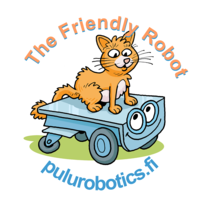How to build autonomous robot for less than 2K€
Build a robot doing Simultaneous Localisation And Mapping cheaply
- Track: Embedded, mobile and automotive devroom
- Room: UB2.252A (Lameere)
- Day: Sunday
- Start: 10:30
- End: 11:00

Telepresence, Delivery Boy, Security and Follow Me in one PULUrobot. PULUrobot solves the autonomous mobile robotics complexity issue without expensive parts, without compromise.
By fearless integration and from-scratch design, our platform can do SLAM, avoid obstacles, feed itself, and carry payload over 100kg, for less than 2000EUR.
Application ecosystem can be born around it, as we offer a ready-made Open Source (GPLv2) solution in a tightly coupled HW-SW codesign.
No need to solve a ROS module puzzle, or pay $50000 for a closed product anymore!
Pulu Robotics Oy's chief HW/SW designer Antti Alhonen presents the new open source startup to the community.
Pulu Robotics Oy was founded in July, 2017, in Finland, to solve our own needs, with an efficient team of three. No one had prior knowledge on robotics.
By studying the market and other startups, we realized the common mistake is to use "robotic modules" as building blocks. They are highly expensive, provide little bang for buck, often are inefficient, and require complex software middleware (such as ROS) as the glue inbetween.
Due to our combined background in mechanical, electrical, software and manufacturing design, we took the approach of designing as much as possible by ourselves.
A Bill-of-Materials example: instead of spending $100 on a BLDC motor driver module, our $100 main PCB integrates two such motor controllers - and a 100W li-ion charger, 5V 10A power supply, MEMS compass, accelerometer, two 3-axis gyroscopes, power IO, and a powerful microcontroller.
Having low-level calculation resources available right where the sensor data is first acquired means good data synchronization, low-latency reaction, and this simplifies the higher level software requirements. We actually love the power of embedded!
During the process, we found out that we simply don't need ROS - we already solved most of the puzzle on the lowest level possible, simply and efficiently.
It's often said that it's hard and slow to develop custom HW/SW from scratch. This has clearly not been the case: it took us 4 months from total zero to completely design all the electronics, embedded software, simple prototype Simultaneous Localization and Mapping (SLAM) software, etc., to build the first actual prototype that could autonomously explore its surroundings, perform navigation tasks, and find its own charger. At that point, we thought about the open source business model, established the company, thinking: this is too good to keep in our own basement.
The code footprint for embedded, higher level backend, and user interface frontend is currently 30 000 lines total.
We still have a long way to go. We are now selling the very first generation of robots for the early adopters, hoping to give a kick start to the open source community as soon as possible. Behind the curtains, we are focusing on the development of our next 3D sensor system, which will replace the current scanning 2D lidar with a 360x90 degree full 3D distance data, and do it for the same price we currently pay for the Scanse 2D lidar used in the first small-scale production batch.
Speakers
| Miika Oja (PuluMan) |